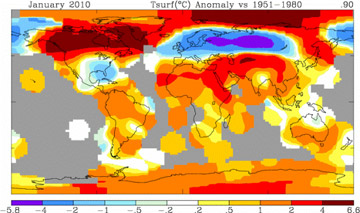This is the second in a series of tropical forest policy commentaries John-O Niles will be writing for Mongabay.com. John-O is the Director of the Tropical Forest Group.
The
Copenhagen Accord, forged at COP15 upended international efforts to confront
climate change. Never before have 115 Heads of State gathered together at one
time, let alone for the singular purpose of crafting a new climate change
agreement. Even though the new Accord is still in intensive care, two things
are already clear. First, we have entered an entirely new world. And second,
tropical forests have the greatest potential to breathe life into the new
agreement.
A New World
The
old world, embodied by the Kyoto Protocol, was black and white. Only two types of
countries existed – “developed” (wealthy) countries that agreed to cap their
own greenhouse gases and “developing” countries that had no specific obligations
to reduce emissions. Developing countries could however reduce their emissions
and then sell UN-verified rights to emit, also know as carbon credits. The
Kyoto Protocol capped emissions from developed countries and instituted a
trading system in certified emissions reductions. All the accounting was
monitored by the United Nations Framework
Convention on Climate Change (UNFCCC), its Secretariat, and its bodies.
The
Kyoto Protocol drove a $125
billion per year industry in pollution abatement (carbon credits) dominated
by Europe’s greenhouse gas trading system and the Clean Development Mechanism. Real
money changed hands ostensibly to reduce greenhouse gases. And while some of
the emissions reductions were not additional
(that is they were not genuine reductions in greenhouse gases) for the most
part the CDM carbon market channeled money to reduce greenhouse gases. The
Kyoto Protocol worked but was also staggeringly complex. Thousands of pages of
methodologies, protocols, guidelines, standards, tests, and registration
systems were required. Consultants consumed a lot of the green investments.
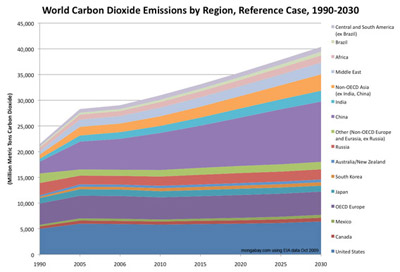 Past and projected carbon dioxide emissions by region, 1990-2030. Click image to enlarge. |
In addition to
its complexity, the Kyoto Protocol was politically flawed. The largest emitters
either had no obligations to reduce (China, India, Brazil, and Indonesia) or
simply chose not to (the US and Canada). The Clinton administration had helped
write the Kyoto Protocol and had set a “cap” for US emissions, but the Bush
administration quickly made it clear the US would not uphold this commitment.
The US never acceded to the Kyoto Protocol despite being the largest economy in
the world, the largest annual emitter until 2006 (when China became the largest
emitter), and the chief architect of the cap and trade system.
The US withdrawal
could have capsized the ship, but Europe and its allies persevered to keep it
afloat. Climate change policy from 2000 to 2008 could be summed up as Europe
biting the bullet and imposing higher costs to pollute. This led to China, India, Brazil and
Mexico making money from Europe’s leadership by generating offsets.
If
the old regime was a black and white world (countries with caps and countries
without caps), the new political reality for climate change cooperation is
multi-colored. Under the Copenhagen Accord, all major countries are stating
quantitatively what they will try to by 2020 to combat climate change. That is
the good news.
Tropical forests have the greatest potential to breathe life into the new agreement. |
The
bad news is it doesn’t add up to a significant reduction in global warming.
Embodied by the Copenhagen Accord, a scant 12-paragraphs and 1361 words, the
new world is still largely aspirational. The Copenhagen Accord rests in legal,
political and environmental limbo. There is no flesh on the agreement and it is
unclear where the authority sits. Yet despite its flaws the Copenhagen Accord
does a good job bringing key players to the table to sign up for real
reductions across a variety of spheres, industries, and sectors all around the
world. There are vague assurances that the reductions will be measured,
reported and verified.
While
the new Accord would solve some of the major defects of the Kyoto Protocol, it
is still unclear if this agreement will be an asset to climate change
cooperation or a setback. How could this happen after years of negotiation? How
could the majority of Heads of State gather on one of humankind’s most pressing
problems and come up with an Accord that remains ambiguous?
Two Overarching Problems Leading Up
To Copenhagen
Although a
gross oversimplification, there were two key problems affecting the talks.
China/US
relations set up a difficult dynamic for getting a deal at Copenhagen. The US
under the Obama administration wanted to reinvigorate the climate change
process but needed to wrestle substantial concessions out of China and other
large emitters. Without a clear signal that developing countries would also
undertake emission cuts, Obama’s team would never be able to get Congress to
pass aggressive climate change policies. But China was not interested in
hearing another US lecture (especially when the US had no moral ground to stand
on, having walked away from the Kyoto Protocol). America’s executive branch
wanted to show leadership, but has been dealing with a hostile Congress, two
wars, a severe recession and the fact that China owns almost a trillion dollars in
US Treasury Securities. A host of overarching economic, military and strategic
issues between the two greenhouse gas giants was complicating a climate change
deal.
The process
for creating a new climate change accord was also under immense strain
politically and logistically. The actual UNFCCC negotiating process had become
virtually unworkable due to extraordinary complexity. Six separate and
interrelated UN “bodies” were negotiating the agreement for 192 countries in 6
official UN languages with hundreds of pages of draft agreements, each often
riddled with brackets indicating disagreement among nations. The UNFCCC did a
good job holding the whole system together for years. But going into the
Copenhagen talks, the UNFCCC was operating at the outer bounds of international
diplomacy in terms of technical work and organization.
An Accord Rises from the Ashes
Going into
COP15, there was an unwieldy 200-page negotiating document as well as dozens of
“non-papers” and other draft decisions. The whole process was supposed to get
wrapped into a cohesive global strategy for combating climate change. As the
Copenhagen meetings opened, diplomats had less than two weeks to eliminate all
differences in time for the historic congregation of world leaders. That did
not happen.
Instead,
midway through the second week of the two-week talks, the effort to reach a
detailed agreement fell apart. Chaos ensued and consensus could not be reached.
The precipice of a new deal became the precipice of failure. Negotiating
documents that had been years in the making were largely (though not completely)
discarded and the Copenhagen Accord was hastily assembled by a few Heads of
State and inner circles. To this date, it is not clear who wrote the initial
draft. (On what laptop did the nascent hurried accord get typed?) It was then
rather unceremoniously introduced to the world as the new agreement, with Heads
of State jetting home without any formal signing ceremony.
For observers
of this process, it was surreal. Years of work by thousands of scientists,
diplomats and observers literally evaporated. In its place is, well…no one is
quite sure. Pundits from around the world and across various political spectra
are weighing in, some declaring the Copenhagen Accord a flop, others calling it
a tentative success, and almost everyone saying it is too soon to tell.
What is the Copenhagen Accord?
The new
Copenhagen Accord consists of a list of countries, 12 paragraphs and two
Appendixes. It calls for massive new funding for climate change abatement and
adaptation and it creates four new UN “bodies” to help us get from point A to
point B. As
of April 2, 2010, 115 countries have associated with the Accord and 75
countries representing 80% of global greenhouse gas (GHG) emissions have made
public declarations to reduce GHGs.
The Two Appendixes: Declarations of
Commitments
So
far, most of the major greenhouse gas emitters have sent in their intentions
and the submissions will be organized into the two Appendixes (one for
developed countries and one for developing countries). Countries are publicly
declaring how much of an emission cut they think they can achieve between now
and 2020.
For the most
part, developed nations are saying they will reduce their
emissions absolutely. The United
States announced a target of a 17% reduction in greenhouse gases below a
2005 baseline. Europe will strive to cut its emissions by a more aggressive 20%
to 30% below 1990 levels.
Developing nations
are making different declarations. India and China have said they will reduce the
intensity of their emissions (emissions per unit of economic output). And while
not yet an absolute reduction, these are important concessions. The cuts these
large developing countries have proposed are a significant step beyond what was
required of them by the Kyoto Protocol. Mexico, which is hosting the next
Conference of the parties (COP16), has said it
will reduce its emissions by 30% by 2020. Most developing countries are
making emission reductions commitments contingent on adequate financing by
developed nations. They are going on record that they will undertake
substantial measures to cut their greenhouse gas emissions if assistance is
provided by the wealthiest countries.
Importantly,
countries are registering commitments based on what they think is politically
feasible given their domestic circumstances. A critical player here, once
again, is the United States. Three US administrations (Clinton, Bush, and
Obama) failed to submit the Kyoto Protocol to the US Senate for ratification since it never
would have mustered the requisite two-thirds majority vote. After Copenhagen,
the US “signed up” to reduce its emissions by 17% below 2005 levels – an
emission reduction cut on par with what was in congressional legislation at the
time. Now, even that modest ambition already seems unattainable. With changes
in the US Senate after Copenhagen, congress has officially has ditched its
previous plans for an ambitious cap and trade framework. At this point, if any
US climate and energy legislation is enacted by congress (itself a long shot),
the legislation will almost certainly not achieve the Obama administration’s
Copenhagen goal.
Money
The Copenhagen
Accord states that it is the intention of developed countries to leverage $100
billion per year by 2020 to assist developing countries mitigate and adapt to
climate change. The Accord also calls for the immediate leveraging of $35
billion in fast track funding over the next three years. On the sidelines of
the Copenhagen meetings, Australia, the UK, France, Norway, Japan and the US
announced that of the $35 billion in funds, $3.5
billion would be committed to REDD+ internationally over the next few years including $1
billion from the United States.
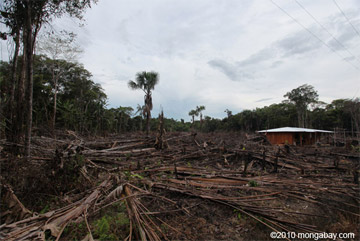 Deforestation in Colombia. |
All of these
pledges are staggering. They represent an immediate opportunity to accelerate
cooperative efforts on climate change mitigation and adaptation. Many groups
are already working to ensure that financial pledges made in Copenhagen will be
honored. Early indications suggest some developed governments will repackage
existing aid commitments and the Copenhagen monies will not be anything new.
Still, developed nations have started reaching into their pockets in an
unprecedented way.
Four New Entities
In addition to
the stated emission reduction goals and the money pledged by wealthy nations,
four new UN “bodies” were created by the Copenhagen Accord. These four bodies
include the “REDD+ Mechanism”
(paragraph 6); the Copenhagen Green
Climate Fund set to handle $30 billion in funding until 2012 and up to $100
billion per year by 2020 (paragraph 8); a High
Level Panel to study the contribution of the potential sources of revenue
(paragraph 9); and a Technology
Mechanism to “accelerate technology development and transfer in support of
action on adaptation and mitigation.” (paragraph 11).
High Level Panel
This body is
unlikely to be critical. It has a fuzzy mandate to study potential sources of
revenue and is not going to significantly solve climate change.
The Copenhagen Green Climate Fund
(CGCF)
Importantly,
the donations (some might say reparations) pledged by rich counties for poor
ones will be loosely coordinated by the CGCF. While not likely to wield great
authority initially, the CGCF will probably keep track of and set some basic
rules for how individual donors spend and account for their stated pledges. In
the Copenhagen Accord, the CGCF has a loose affiliation with the UNFCCC process
and its supreme body, the Conference of Parties (COP). If in fact there will be
$100 billion in carbon finance annually by 2020 (a huge “if”), then whatever
body helps oversee these funds will be an important one. And the language in
the Copenhagen Accord tying the CGCF to the original UNFCCC creates a necessary
hitch between the old world and the new.
Mechanisms: Technology and REDD+
The Copenhagen
Accord also creates two new mechanisms. Mechanisms in climate change policy are
how developed and developing countries shake hands, pay for, and measure
emission reductions. Under the Kyoto Protocol, it was the Clean Development
Mechanism (CDM) that oversaw the carbon market between developed and developing
nations. The CDM was only a ten-paragraph Article (Article 12) yet its
implementation channeled hundreds of billions of dollars in green investments.
The two new mechanisms in the Copenhagen Accord have the potential to become
vital engines for climate change mitigation. But, right now, these two
mechanisms have been authorized by an accord that has no clear authority.
 Rainforest in Colombia. |
Of the two
mechanisms, the REDD+ mechanism is conceptually more advanced. (This despite
that in the Copenhagen Accord, the Technology Mechanism is capitalized and the
“mechanism including REDD+” is lower case. In international treaties, sometimes
small
typographic differences can matter.) Regardless of the diminutive form of
the REDD+ mechanism, it rests on a vaster body of information, decisions and
agreements. REDD has its own Web Platform at
the UNFCCC. This is the result of the Bali Road map and agreement by
Parties that it was important to share technical and scientific information on
REDD. There is no such platform for technology transfer. And from 2005 to 2009,
just as the world was trying to retool its overarching climate change strategy,
REDD+ had a series of technical workshops,
meetings, reports and international agreements about many core REDD+ issues. REDD
is the only sector of the global economy that has a long string of negotiated
texts and UN decisions. This is not the case for technology (and the Technology
Mechanism). Compared to any other issue in global environmental sustainability,
REDD+ is a paragon on technical and diplomatic progress.
Further
confirming REDD+’s front runner role, during the Copenhagen talks a subsidiary
negotiating track adopted a decision called “Methodological
guidance for activities relating to reducing emissions from deforestation and
forest degradation and the role of conservation, sustainable management of
forests and enhancement of forest carbon stocks in developing countries.” This text that was adopted by consensus sets in motion a series of
next steps for REDD+ in the UNFCCC process. One part of the decision was to
request developing countries to “establish robust and transparent national
forest monitoring systems and, if appropriate, sub-national systems as part of
national monitoring systems” and to make the results available for review by
the Conference of the Parties. This small part of negotiated text is actually a
breakthrough. It suggests if developing countries and sub-national levels of
governments (state and provinces) can reduce emissions from deforestation and
get emissions reductions reviewed by the UNFCCC process, this could lead to
financial support and incentives from the developed nations. This will become a
major focus of diplomatic work over the next years and could facilitate
substantial new levels of sustainable finance for countries that demonstrate
real reductions in deforestation.
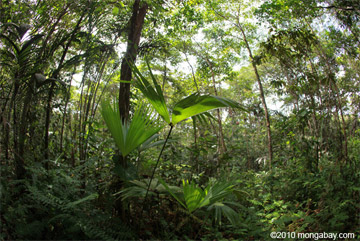 |
Now the door
is open for governors from developing countries, not just countries themselves,
to stop deforestation and access incentives. If governors can measure, report
and verify (MRV in climate change vernacular) the reductions, presumably carbon
finance will be unleashed. This does not mean federal governments are cut out
of the process, just that states and provinces can move at their own pace to
recruit carbon finance and stop deforestation.
The
sub-national issue of REDD+ is fundamental for another reason. Recently a
growing number of state and provincial governors from the US, Indonesia,
Brazil, Nigeria, and Mexico have been working on the Governors’ Climate and Forests Taskforce,
initially spearheaded by California. This GCF Taskforce includes governors of
around 50% of the world’s forests (in the US, Mexico, Indonesia, and Nigeria).
These governors (some of the most progressive environmental leaders of our
time) and their staffs are working to fast-track REDD+ activities and finance.
One key arena where this may occur is under California’s landmark climate
change legislation, the Global
Warming Solutions Act. Often, what California adopts for rules in
environmental circles eventually filters up to the US federal level. The GCF
holds its next meeting in May in Aceh, Indonesia and has been working on a
series of measures to build a REDD+ regulatory framework for states and
provinces. The governors of the Taskforce are moving faster than either the
Copenhagen Accord, the UNFCCC or the US legislative processes. They are also
moving faster in most cases than their federal counterparts. It is plausible
that the GCF could streamline international efforts and bring substance to the
lofty opportunities of the REDD+ mechanism. The Copenhagen decision clearly
allows this type of forest conservation to be measured, verified and ideally,
funded.
What the Copenhagen Accord doesn’t
do.
The Copenhagen
Accord does not provide a coherent framework. The key question is whether and
how the Copenhagen Accord can get “stitched” to the better parts of the UNFCCC
and the Kyoto Protocol and cover new ground. There are a few references in the accord to the Convention
but this relationship is not yet codified. This will be a primary focus for
negotiators in 2010. The Copenhagen Accord also does not indicate whether
developed nations will continue to use measured emission reductions in
developing countries. Without this demand for credits, the carbon market that
has defined much of the current efforts to fight climate change will be
seriously and negatively impacted. The Copenhagen Accord also fails to
establish penalties for countries that do not meet their stated obligations.
Is the Copenhagen Accord Enough?
See REDD+ for Answer
A
central question facing this planet is whether the Copenhagen Accord, born from
chaos at the highest levels of global governance, is up to the monumental job
of slowing and reducing greenhouse gas emissions. To be effective, the
Copenhagen Accord must reduce CO2 emissions rapidly enough to avoid significant
disruption to the thin film of life surrounding our planet.
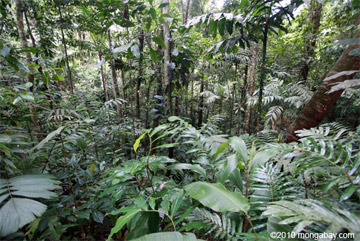 |
Whether the
Copenhagen Accord is ultimately successful may be largely decided by what
happens with REDD+ and the world’s remaining tropical forests. As the world
tries to resuscitate the UNFCCC process, REDD+ is the most promising concept in
a turbulent time. REDD+ is the frontrunner in the twisting race to reach
political agreement on climate change. There are various forums where REDD is
being advanced (the UNFCCC, the UN REDD Web Platform, the World Bank, UN-REDD,
the GCF and communities and indigenous lands worldwide). REDD+ has a mechanism
in the Copenhagen Accord, a shared history of adopted technical decisions, and
an immediate infusion of funding. With all that as a backdrop, efforts over the
next three years to reign in emissions from tropical deforestation and promote
sustainable land use practices will be the most important area of global
climate change policy to watch and support.
REDD+ is the frontrunner in the twisting race to reach political agreement on climate change. |
The evolution
and progress of the new REDD+ mechanism will significantly influence the
overall trajectory of international climate change policy. If REDD+ goes well –
and developed countries leverage significant resources to help developing
countries stem deforestation – this positivity could spill into other areas of
international cooperation. If REDD+ goes sour, prospects for successful climate
change mitigation and adaptation significantly dim.
The work kicks
off again with the first formal round of negotiations after the Copenhagen
meetings in Bonn
Germany from April 9 to April 11, 2010. Stay tuned for more news, here on
mongabay.com or at http://tropicalforestgroup.blogspot.com/.
John-O Niles
is the Director of the Tropical
Forest Group.
Related articles
A New Idea to Save Tropical Forests Takes Flight

(06/29/2009) Every year, tens of millions of acres of tropical forests are destroyed. This is the most destabilizing human land-use phenomenon on Earth. Tropical forests store more aboveground carbon than any other biome. They harbor more species than all other ecosystems combined. Tropical forests modulate global water, air, and nutrient cycles. They influence planetary energy flows and global weather patterns. Tropical forests provide livelihoods for many of the world’s poorest and marginalized people. Drugs for cancer, malaria, glaucoma, and leukemia are derived from rainforest compounds. Despite all these immense values, tropical forests are vanishing faster than any other natural system. No other threat to human welfare has been so clearly documented and simultaneously left unchecked. Since the 1992 Rio Earth Summit (when more than 100 heads of State gathered to pledge a green future) 500 million acres of tropical forests have been cut or burned. For decades, tropical deforestation has been the No. 1 cause of species extinctions and the No. 2 cause of human greenhouse gas emissions, after the burning of fossil fuels. For decades, a few conservation heroes tried their best to plug holes in the dikes, but by and large the most diverse forests on Earth were in serious decline.
